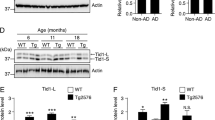Abstract
The pathological mechanism of Alzheimer’s disease (AD) needs to be elucidated. The Bcl-2 associated athanogene 5 (Bag5) is an important member in the Bag family. However, the role of Bag5 in AD has not yet been elucidated. In this study, we found that expression of Bag5 is elevated in the brains of AD transgenic Tg2576 mice at both mRNA levels and proteins. In vitro experiments indicated that Aβ1-42 treatment led to the upregulation of Bag5 in a dose-dependent manner. In addition, our results indicated that inhibition of Bag5 using small RNA interferences exacerbated Aβ1-42-induced neurotoxicity. On one hand, 3-(4,5-dimethylthiazol-2-yl)-2,5-diphenyl-tetrazolium bromide (MTT) and lactate dehydrogenase (LDH) assay demonstrated that inhibition of Bag5 exacerbated Aβ1-42-related cell death. On the other hand, silence of endogenous Bag5 promotes the generation of reactive oxygen species (ROS) and malondialdehyde (MDA) induced by Aβ1-42. Finally and importantly, it was shown that knockdown of Bag5 exacerbated Aβ1-42-induced apoptosis and caspase-3 cleavage. These data suggest that induction of Bag5 might have a neuroprotective effect in AD.





Similar content being viewed by others
References
Beilina A, Rudenko IN, Kaganovich A et al (2014) Unbiased screen for interactors of leucine-rich repeat kinase 2 supports a common pathway for sporadic and familial Parkinson disease. Proc Natl Acad Sci U S A 111(7):2626–2631
Bonelli P, Petrella A, Rosati A et al (2004) BAG3 protein regulates stress-induced apoptosis in normal and neoplastic leukocytes. Leukemia 18(2):358–360
Briknarova K, Takayama S, Homma S et al (2002) BAG4/SODD protein contains a short BAG domain. J Biol Chem 277(34):31172–31178
Bruchmann A, Roller C, Walther TV et al (2013) Bcl-2 associated athanogene 5 (Bag5) is overexpressed in prostate cancer and inhibits ER-stress induced apoptosis. BMC Cancer 13:96
Chung KK, Dawson TM (2004) Parkin and Hsp70 sacked by BAG5. Neuron 44(6):899–901
Dahlgren KN, Manelli AM, Stine WB Jr et al (2002) Oligomeric and fibrillar species of amyloid-beta peptides differentially affect neuronal viability. J Biol Chem 277:32046–32053
Fernandez A, Llacuna L, Fernandez-Checa JC, Colell A (2009) Mitochondrial cholesterol loading exacerbates amyloid beta peptide-induced inflammation and neurotoxicity. J Neurosci 29:6394–6405
Glenner GG, Wong CW (1984) Alzheimer’s disease: initial report of the purification and characterization of a novel cerebrovascular amyloid protein. Biochem Biophys Res Commun 120(3):885–890
Hardy J, Selkoe DJ (2002) The amyloid hypothesis of Alzheimer’s disease: progress and problems on the road to therapeutics. Science 297(5580):353–356
Kabbage M, Dickman MB (2008) The BAG proteins: a ubiquitous family of chaperone regulators. Cell Mol Life Sci 65(9):1390–1402
Kong Y, Grimaldi M, Curtin E et al (2014) Neural crest development and craniofacial morphogenesis is coordinated by nitric oxide and histone acetylation. Chem Biol 21(4):488–501
LaFerla FM, Oddo S (2005) Alzheimer’s disease: Aβ, tau and synaptic dysfunction. Trends Mol Med 11:170–176
Ma M, Wang X, Ding X, Jing J, Ma Y, Teng J (2012) Protective effect of BAG5 on MPP+ -induced apoptosis in PC12 cells. Neurol Res 34(10):977–983
Ohkawa H, Ohishi N, Yagi K (1979) Assay for lipid peroxides in animal tissues by thiobarbituric acid reaction. Anal Biochem 95:351–358
Pollock NJ, Mirra SS, Binder LI, Hansen LA, Wood JG (1986) Filamentous aggregates in Pick’s disease, progressive supranuclear palsy, and Alzheimer’s disease share antigenic determinants with microtubule-associated protein, tau. Lancet 2(8517):1211
Sheng B, Gong K, Niu Y et al (2009) Inhibition of gamma-secretase activity reduces Abeta production, reduces oxidative stress, increases mitochondrial activity and leads to reduced vulnerability to apoptosis: implications for the treatment of Alzheimer’s disease. Free Radic Biol Med 46(10):1362–1375
Takayama S, Bimston DN, Matsuzawa S et al (1997) BAG-1 modulates the chaperone activity of Hsp70/Hsc70. EMBO J 16:4887–4896
Teixeira J, Silva T, Andrade PB, Borges F (2013) Alzheimer’s disease and antioxidant therapy: how long how far? Curr Med Chem 20(24):2939–2952
Townsend PA, Curtess RI, Sharp A et al (2003) BAG-1: a multifunctional regulator of cell growth and survival. Biochim Biophys Acta 1603:83–98
Valko M, Leibfritz D, Moncol J et al (2007) Free radicals and antioxidants in normal physiological functions and human disease. Int J Biochem Cell Biol 39(1):44–84
Wang X, Guo J, Jiang H et al (2010) Direct interaction between BAG5 protein and Parkin protein. Zhong Nan Da Xue Xue Bao Yi Xue Ban 35(11):1156–1161
Wang X, Guo J, Fei E et al (2014) BAG5 protects against mitochondrial oxidative damage through regulating PINK1 degradation. PLoS One 9(1):e86276
Author information
Authors and Affiliations
Corresponding author
Rights and permissions
About this article
Cite this article
Guo, K., Li, L., Yin, G. et al. Bag5 Protects Neuronal Cells from Amyloid β-induced Cell Death. J Mol Neurosci 55, 815–820 (2015). https://doi.org/10.1007/s12031-014-0433-1
Received:
Accepted:
Published:
Issue Date:
DOI: https://doi.org/10.1007/s12031-014-0433-1




